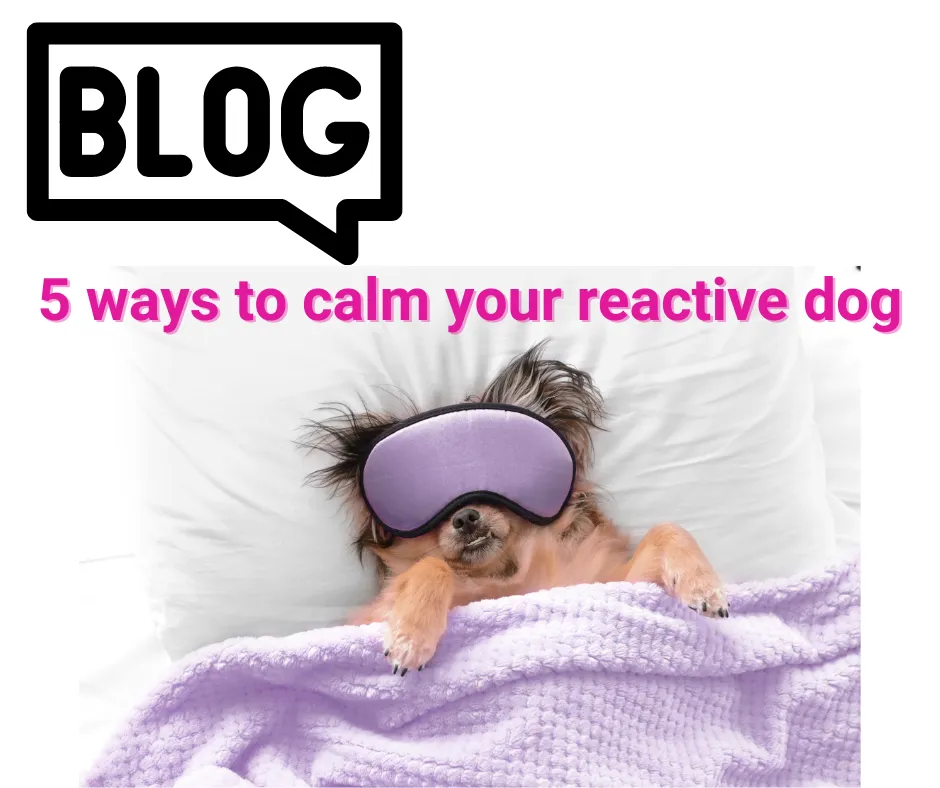Book a FREE 1:1 Assessment Call By Clicking HERE
Specialising In Dog Reactive Behviour
Accredited by APDT, ABTC and UK DOG Behaviour and Training Charter
Qualified and Experienced
Force Free Trainer and Behaviourist
Dog Training Leicestershire Educational Blogs

5 ways to calm your reactive dog
5 Ways To Calm Your Reactive Dog
Reactive dog behaviour can present numerous challenges for both dog owners and their dogs. Reactive dogs often display intense fear, anxiety, or aggression towards stimuli, these can be dogs, strangers, or loud noises or sometimes things that we are not aware of.
This reactive behaviour can make it difficult for owners to manage their dogs in public spaces and can lead to stressful situations for all involved.
Start by identifying behavioural triggers for your dog reactivity
It is important to recognise that reactive behaviour is not a choice made by the dog but rather a response to perceived threats or triggers. Understanding the root causes of reactive behaviour, such as past trauma or lack of socialisation, is crucial in developing effective training methods to help these dogs overcome their fears and anxieties.
In this comprehensive guide, we delve into the world of canine reactivity and explore effective methods to bring calmness to our furry companions. Understanding the underlying causes of reactivity is essential to address and alleviate anxiety in dogs. We also explore training techniques that can be employed to teach dogs how to remain calm on command. Additionally, we discuss holistic approaches and natural remedies that can contribute to a serene and well-balanced pooch. Join us as we uncover soothing solutions for reactive dogs.
Can A Reactive Dog Be Cured?
1. Understanding why your dog reacts is a key element in helping your dog rescue their reactivity.
Reactivity in dogs can manifest as percieved aggressive behaviour which is usually fearful behaviour towards certain stimuli, such as other dogs, humans, or loud noises. Understanding the underlying causes of this reactivity to address and manage it effectively is essential.
While each dog is unique, common triggers include past experiences causing negative emotions, trauma, breed influences, pwner influence as well as health and diet.
Working on changing emotions and identifying specific triggers and situations that elicit reactive behaviour in their dogs, owners can begin to implement targeted counter conditioning and desensitisation techniques to change behaviour.
Reactive dog behaviour can be cured when you give them time, space, understand why they are behavioung that way and implement a behaviour modification plan.
Professional help from a behaviourist dog trainer may be necessary to develop a tailored approach for each dog. Understanding the causes of reactivity is the first step towards helping our furry friends lead happier and more peaceful lives.
What Not To Do With A Reactive Dog
Using punishment and making them face their fears will make it worse. They need to be made to feel calm and safe at all times.
Calm: Training Techniques to Ease Canine Anxiety
Training techniques can be highly effective in easing canine anxiety and helping reactive dogs become more calm and relaxed. One proven successful technique is teaching and promoting relaxation. For example, teaching mat training on can help your dog relax at home. This will help reduce the stress hormone cortisol which stays in the dogs system and triggers behavioural responses.and provide a sense of security.
Regular scent training, lick mats, snuffle mats, chews and regular rest are all great stress busters. The act of doing these releases Neuro-transmitters that lower cortisol, inducing feel good hormones and enriches your dogs life, building optimism and generally makes them happy.
This helps them develop a more positive association with those triggers over time. Positive reinforcement, consistency, and patience are key when using these training techniques to help ease canine anxiety.
3 Holistic Approaches: Natural Remedies for a Serene Pooch
When it comes to calming a reactive dog, many pet owners are turning to holistic approaches and natural remedies. These methods focus on treating the underlying causes of anxiety rather than just managing the symptoms.This can involve pre and pro biotics to improve gut micro-biome which aid the release of the mood stabiliser seratonin and feel good hormones dopamine.
A popular option is aromatherapy, using essential oils like lavender or chamomile to create a soothing environment for your furry friend. Another effective natural remedy is the use of herbal supplements such as valerian root or passionflower, which can help reduce stress and promote relaxation. Additionally, acupuncture and massage therapy have shown promising results in reducing anxiety in dogs. By exploring these holistic approaches, pet owners can provide their beloved pooches with a serene and calm environment, promoting their overall well-being.
4. Space away from triggers
It can be tempting to take your dog out regualrly thinking that the will 'get used to it' believing that their behaviour will improve when you do this. However, this approach will prove ineffective. Your dog's behaviour is a form of communication, indicating their struggle within the given situation. Focus on building confidence, optimism, and the ability to approach situations differently.
Address this issue initially at home away from triggers where your dog is calm and can learn.
When outside create space by turning the opposite way to the triggers, or crossing the road where possible. If you are unable to do this, gently guide your dog away from the trigger while offering verbal reassurance and gentle strokes until the trigger has passed.
5. You need to be calm.
Your dog is able to pick up on your stresses and fears. When you are tense they can feel it and their stress and fear will increase.
If you are calmer and can help your dog remain calm through positive words, a gentle touch and tasty treats they will be more confident in the situation.
'A study showed that there is a potential for extreme negative emotional responses and feelings of failure are experienced by owners when their dog reacts badly towards another dog or person'.
Should You Correct Your Reactive Dog?
No, the reactions are a reflex response. Your dog is not choosing to react this way. Their brain is driving responses to keep them safe.
Correcting the behaviours will only add negative feelings, Your aim isn't to stop the behaviour. Your aim is to change the emotions of why they dog is reacting in that situation.
When you change emotions there will be no need for the behaviour.
Conclusion
It is clear that understanding the root causes of their anxiety is key to finding effective ways to calm them. Training techniques and holistic approaches offer promising avenues for helping our furry friends find calm which will help reduce adverse behavioural responses.But let us not forget the importance of patience and empathy in this journey. How can we further promote a more compassionate approach to addressing canine reactivity?
Rovers Return Dog Training and Behaviour, based in Leicester offer programs that give you the confidence to manage and change your dogs reactive behaviour. Book your free call now
Highly Qualified Behaviourist
Accredited by APDT, ABTC and UK DOG Behaviour and Training Charter
Accredited Scentwork Instructor
Force Free Trainer and Behaviour
Force Free Trainer and Behaviour
Accredited Scentwork Instructor
Accredited by APDT, ABTC and UK DOG Behaviour and Training Charter
Highly Qualified Behaviourist
Contact Us
Sam: 07725 802995
You can contact us via Live Chat button at the bottom of the screen or the contact box to the right.
You can also book one of our services online using the View Dates buttons under the service you require.
© 2023 by Rovers Return Dog Trainers Academy - Force Free Dog Training Lutterworth, Broughton Astley, Leicestershire, Hinckley, Nuneaton, Stoney Stanton, South Kilworth, Ullesthorpe
Privacy Policy | Terms and Conditions | Terms and Conditions of Services | Sitemap





Facebook
Instagram
X
LinkedIn
Youtube
TikTok